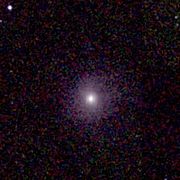NGC 474
Coordinates: ![]() 01h 20m 06.7s, +03° 24′ 58″
01h 20m 06.7s, +03° 24′ 58″
| NGC 474 | |
|---|---|
 A Hubble Space Telescope image of NGC 474. (NASA, STScI, Sky-map.org) | |
| Observation data (J2000[1] epoch) | |
| Constellation | Pisces[2] |
| Right ascension | 01h 20m 06.7s[1] |
| Declination | +03° 24′ 58″[1] |
| Redshift | 0.007755[1] |
| Helio radial velocity | 2325 km/s ±7 km/s[1] |
| Galactocentric velocity | 2398 km/s ±7 km/s[1] |
| Distance | ~100 Mly (~31 Mpc)[2] |
| Characteristics | |
| Type | S0[3] |
| Size | 250,000 ly (diameter)[4] |
| Other designations | |
| Arp 227, MCG 0-4-85, PGC 4801, UGC 864, ZWG 385.71[3] | |
NGC 474 is an elliptical galaxy about 100 million light years distant in the constellation Pisces. This large galaxy is known to possess tidal tails, although their origins remain unknown.[2] One possible explanation is that NGC 474 interacted with a galaxy several billion years ago.[5]
NGC 474 is known to have tidal tails, but their origins remain somewhat unknown. In 2020, a possible explanation was published. The authors of the study argued that the tidal tails were formed because of a collision with a galaxy 2 billion years ago.[5] The same study also states that NGC 474 is absorbing gas from its neighbor, NGC 470, since the ancient collision. [5]
In July 2017 a Type Ia supernova designated SN 2017fgc was discovered in NGC 474.[6] It was located at a considerable distance from the galactic nucleus.[7]
Gallery[]

NGC 474 (2MASS)

SDSS image of NGC 474.

Elliptical galaxy NGC 474 — excerpt from the Dark Energy Survey
Further reading[]
- Turnbull, A. J.; Carter, D.; Bridges, T. J.; Thomson, R. C. (1999) Shell Formation in NGC474
References[]
- ^ a b c d e f "NED results for object NGC 0474*". NASA/IPAC Extragalactic Database. Retrieved 2011-02-26.
- ^ a b c Schirmer, Mischa. "NGC 474". Archived from the original on 2011-06-29. Retrieved 2011-02-26.
- ^ a b "Revised NGC Data for NGC 474". The Interactive NGC Catalog Online. Retrieved 2011-02-26.
- ^ "Galaxy NGC 474". NASA Astronomy Picture of the Day. Retrieved 2018-02-07.
- ^ a b c Alabi, A.B.; Anna, F-M.; Forbes, D.A.; Romanowsky, A.J.; Brodie, J.P. (September 2020). "NGC 474 as viewed with KCWI: diagnosing a shell galaxy" (PDF). Monthly Notices of the Royal Astronomical Society. 497 (1): 626–631. Retrieved 28 June 2021.
- ^ "SN 2017 fgc". Transient Name Server. Retrieved 9 February 2018.
- ^ King, Bob (2017-07-26). "Sky Surprises: New Comet ASASSN1, Nova in Scutum, and Supernova in Pisces!". Sky & Telescope.
External links[]
 Media related to NGC 474 at Wikimedia Commons
Media related to NGC 474 at Wikimedia Commons- Galaxy NGC 474: Cosmic Blender, NASA Astronomy Picture of the Day (8 October 2007)
- Shell Galaxies in Pisces, NASA Astronomy Picture of the Day (27 February 2011)
- Galaxy NGC 474: Shells and Star Streams, NASA Astronomy Picture of the Day (5 January 2014)
- Galaxy NGC 474: Shells and Star Streams, NASA Astronomy Picture of the Day (6 February 2018)
- Lenticular galaxies
- Shell galaxies
- NGC objects
- UGC objects
- Principal Galaxies Catalogue objects
- Pisces (constellation)
- Astronomical objects discovered in 1784
- Lenticular galaxy stubs


